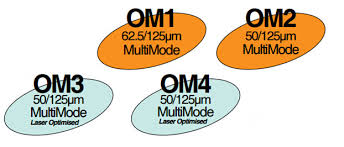Learning how to make a proper selection of fiber optic cable for specific users is growing even important as fiber optic systems become the transmission medium of communications and aircraft applications. The following questions and answers will guide readers through the choices that must be made in selecting fiber optic cable for high-reliability applications.
How to Choose Between Multimode and Single-mode Fiber Cable?
There are two main types of fiber to choose from — multimode and single-mode. The fiber type is predominantly determined by the data rate of the system, transmission distance and cost. Multimode is typically recommended for applications involving shorter distance. If your application only requires transmitting a distance of 550 m or less, multimode fiber optic cables are recommended, which is also a lower cost solution and is often preferred by designers. However, if you need to support longer distances and achieve unlimited bandwidth, single-mode fiber is the best solution. It is recommended for college campuses and metropolitan networks.
There are two main types of fiber to choose from — multimode and single-mode. The fiber type is predominantly determined by the data rate of the system, transmission distance and cost. Multimode is typically recommended for applications involving shorter distance. If your application only requires transmitting a distance of 550 m or less, multimode fiber optic cables are recommended, which is also a lower cost solution and is often preferred by designers. However, if you need to support longer distances and achieve unlimited bandwidth, single-mode fiber is the best solution. It is recommended for college campuses and metropolitan networks.
Where Are You Going to Install the Fiber?
When wondering what types of fiber optic cable should be chosen, you should always take the environment into consideration. For example, if you need to install the fiber optic cable indoor, indoor cables are the ideal choice. These cables are also called tight buffered cable, where the glass fiber has a primary coating and secondary buffer coatings that enlarge each fiber to 900 microns—about 1 mm or 1/25-inch—to make the fiber easier to work with. All these cables can be directly terminated. They are mainly used to connect outside plant cables to terminal equipment, and also for linking various devices in intra-building, risers, general building and plenum applications. The following picture gives you a vivid impression of loose tube cable and tight buffer cable.
When wondering what types of fiber optic cable should be chosen, you should always take the environment into consideration. For example, if you need to install the fiber optic cable indoor, indoor cables are the ideal choice. These cables are also called tight buffered cable, where the glass fiber has a primary coating and secondary buffer coatings that enlarge each fiber to 900 microns—about 1 mm or 1/25-inch—to make the fiber easier to work with. All these cables can be directly terminated. They are mainly used to connect outside plant cables to terminal equipment, and also for linking various devices in intra-building, risers, general building and plenum applications. The following picture gives you a vivid impression of loose tube cable and tight buffer cable.

Moisture resistance and temperature tolerance are the major factors when choosing materials for outdoor environment cables. At these time, you should choose outdoor cables. These cables are also called loose tube cables. Loose tube structure isolates the fibers from the cable structure. This is a big advantage in handling thermal and other stresses encountered outdoors, which is why most loose tube fiber optic cables are built for outdoor applications.
Which Optical Fiber Should I Choose, 50 µm or 62.5 µm?
Although 62.5µm fiber was very popular only a few years ago, 50 µm quickly gained market share and is continuing to do so. 50µm fiber can have up to 20 times the bandwidth of 62.5 µm. 62.5µm multimode is referred to as OM1. 50µm fiber is referred to as OM2, OM3 and the recently added OM4. As you would imagine, OM4 has greater bandwidth than OM3 and OM3 has greater bandwidth than OM2 and OM1.
Although 62.5µm fiber was very popular only a few years ago, 50 µm quickly gained market share and is continuing to do so. 50µm fiber can have up to 20 times the bandwidth of 62.5 µm. 62.5µm multimode is referred to as OM1. 50µm fiber is referred to as OM2, OM3 and the recently added OM4. As you would imagine, OM4 has greater bandwidth than OM3 and OM3 has greater bandwidth than OM2 and OM1.

OM3 fiber is designed to accommodate 10 Gigabit Ethernet up to 300 meters, and OM4 can accommodate it up to 550 meters but OM1 and OM2 only support link lengths of up to 32 m, 82 m, respectively. Therefore, many users are now choosing OM3 and OM4 over the OM1 and OM2. What’s more, if you require higher data rates or plan on upgrading your network in the near future, laser optimized 50 micron (OM3 or OM4) would be the logical choice.
To sum up, finding the correct fiber optic cable might seem like a mammoth challenge, but getting familiar with the above parameters beforehand helps you narrow down your selections. I hope it will be helpful for you!
Originally published at www.fiber-optic-solutions.com
评论
发表评论